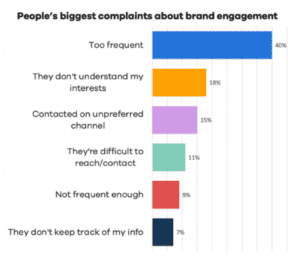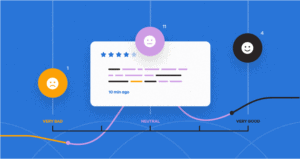Email hygiene is an extremely important part of your email program. If you don’t keep up with it, that can bring big deliverability issues down the line. In order to maintain good email hygiene, you’ll need to keep your content relevant to your audiences, improve and protect your sender reputation, and open more efficient and profitable channels for communication.
Create a Better Brand Experience

- Unwanted email is a bad experience. According to consumers, the top 3 biggest complaints about brand engagement are that they are being contacted too frequently with content they’re uninterested in, they don’t believe the brand understands their interests, and they are not contacted on their preferred channel. If you are paying per email send, you are lowering your ROI if you are sending too many emails and not targeting your subscribers’ particular interests. In essence, you are wasting your money!
- Treat email relationships like real relationships. Listen to your audience and make changes according to their feedback. Be thoughtful and intentional with your language and messaging. Don’t smother your audience by sending too many messages too soon, and be prepared to break up if the relationship is not working.
- Unsubscribes are a gift. Make sure you include a survey in your unsubscribe process so you can gather information on why people are unsubscribing. You can then use this data to improve your program. Also consider being more upfront with your unsubscribe or preference management links by putting them in your header or highlighting them more somewhere within your email. This will both help uninterested users disengage more easily and also boost trust within your brand.
- Not everyone unsubscribes. ‘Emotional Opt Outs’ or subscribers who do not opt out but also do not engage with your emails, can take up more than half of your list if you aren’t careful. This is why you want to be upfront with your subscribers by allowing them to easily manage their preferences and only sending emails based on their preferences.
All in all, you can create a better brand experience by listening to your audience, having an awareness of their relationship stage, and sending them the appropriate amount of contact according to that stage.
Avoid the Pitfalls of Disengagement
- Keep in mind Mailbox Providers and Sender Reputation. Those Emotional Opt Outs can become a pretty big problem when it comes to maintaining a good sender reputation. The job of the Mailbox Providers is to mediate the email experience for their customers – aka your subscribers – and they are focusing much more heavily on how your subscribers are engaging with your emails. They are scanning for messages that were deleted without being read, how quickly messages are being deleted, and general inbox activity like what types of messages are being opened. If the Mailbox Provider determines that a subscriber is not engaged with your messages, they will begin to defer, delay, or even outright block your messages to that subscriber.
- Filter on engagement. To prevent Mailbox Providers from delaying or blocking your messages, take engagement filtering into your own hands. Be proactive and start re-engaging after 1 month of inactivity. Don’t wait until they’ve been unengaged for a longer term because it will be even harder to re-engage them at that point. Also use account and multi-channel data for better segmentation to get a better sense of overall engagement and determine who is truly engaged and active.
- Data Hygiene practices for acquisition and sign-up. On your signup form, introduce email verification like a double opt-in where a verification email is sent to the subscriber, and they must confirm their email before receiving communication from you. This will allow you to not only confirm those who sign up really do want to receive communications from you, but also will help you weed out fake email addresses or emails submitted with a type. You can also add a captcha to your sign-up form as another preventative tool against bots.
- Data Hygiene practices for bounce management. If you are seeing bounces within your email sends, it is good practice to try to update the contact information or remove those contacts from your lists to prevent them from being sent further campaigns. Removing bounced email addresses from your lists is one of the most important things you can do to achieve good deliverability.
Send Better Emails with More Precision

- Survey your users. Ask your audience directly about what they want out of your email program. What frequency do they prefer? What types of content are they interested in? Asking this of your audience on a periodic basis can uncover insights that you might not have had access to previously.
- Create step-downs and opt-downs. Either programmatically or through a preference center, provide a way for your program to match your subscribers’ level of engagement. If someone begins to enter a disengagement zone, provide yourself with the ability to send email to match their level of engagement. Only send them your high engagement content to both respect their estimated desire of frequency and to entice them to interact with you again.
- Build a Preference Center. Provide your audience with the autonomy of choosing their desired frequency and content. Giving them the ability to set their own parameters will allow you to engage with them on their terms and also prevent them from opting out altogether.
- Set frequency rules. Apply filters to control how many mailings a user might receive in a given time period. For example, you could apply a filter that says subscribers will only receive 3 marketing messages per month.
- Know when to say enough. Remove subscribers that have been unengaged for more than 12-18 months, as it is highly unlikely that they will engage again. This will help you maintain a good sender reputation and save on resources and budget.
- Get professional help. Look into list validation services or contact your CSM for more information on the deliverability and strategy consulting we can provide!
